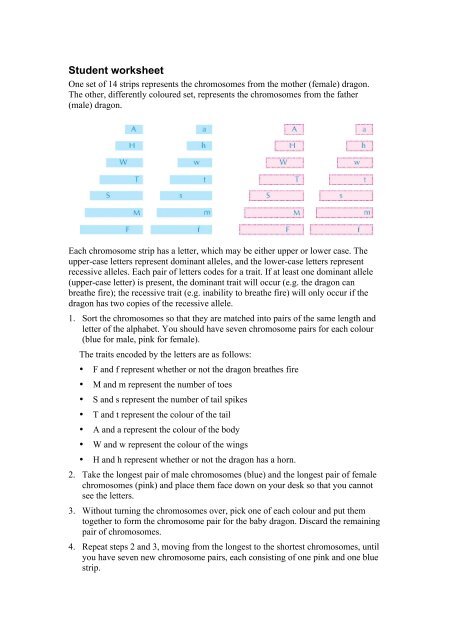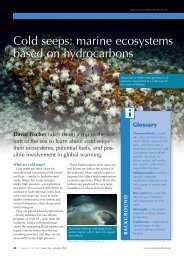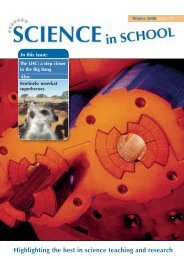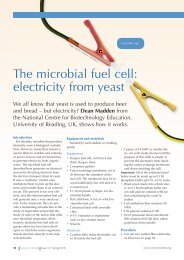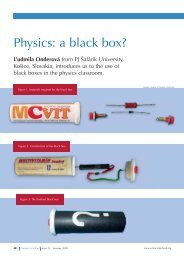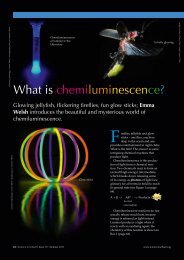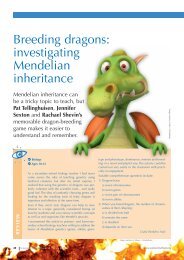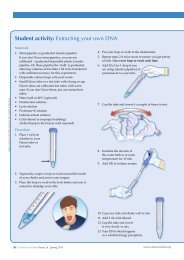Student worksheet - Science in School
Student worksheet - Science in School
Student worksheet - Science in School
Create successful ePaper yourself
Turn your PDF publications into a flip-book with our unique Google optimized e-Paper software.
<strong>Student</strong> <strong>worksheet</strong><br />
One set of 14 strips represents the chromosomes from the mother (female) dragon.<br />
The other, differently coloured set, represents the chromosomes from the father<br />
(male) dragon.<br />
Each chromosome strip has a letter, which may be either upper or lower case. The<br />
upper-case letters represent dom<strong>in</strong>ant alleles, and the lower-case letters represent<br />
recessive alleles. Each pair of letters codes for a trait. If at least one dom<strong>in</strong>ant allele<br />
(upper-case letter) is present, the dom<strong>in</strong>ant trait will occur (e.g. the dragon can<br />
breathe fire); the recessive trait (e.g. <strong>in</strong>ability to breathe fire) will only occur if the<br />
dragon has two copies of the recessive allele.<br />
1. Sort the chromosomes so that they are matched <strong>in</strong>to pairs of the same length and<br />
letter of the alphabet. You should have seven chromosome pairs for each colour<br />
(blue for male, p<strong>in</strong>k for female).<br />
The traits encoded by the letters are as follows:<br />
• F and f represent whether or not the dragon breathes fire<br />
• M and m represent the number of toes<br />
• S and s represent the number of tail spikes<br />
• T and t represent the colour of the tail<br />
• A and a represent the colour of the body<br />
• W and w represent the colour of the w<strong>in</strong>gs<br />
• H and h represent whether or not the dragon has a horn.<br />
2. Take the longest pair of male chromosomes (blue) and the longest pair of female<br />
chromosomes (p<strong>in</strong>k) and place them face down on your desk so that you cannot<br />
see the letters.<br />
3. Without turn<strong>in</strong>g the chromosomes over, pick one of each colour and put them<br />
together to form the chromosome pair for the baby dragon. Discard the rema<strong>in</strong><strong>in</strong>g<br />
pair of chromosomes.<br />
4. Repeat steps 2 and 3, mov<strong>in</strong>g from the longest to the shortest chromosomes, until<br />
you have seven new chromosome pairs, each consist<strong>in</strong>g of one p<strong>in</strong>k and one blue<br />
strip.
5. Turn over the seven pairs of chromosomes of the new baby dragon. For each pair,<br />
record the letter on the blue chromosome <strong>in</strong> the ‘Male gene’ column <strong>in</strong> Table 1<br />
and the letter of the p<strong>in</strong>k chromosome <strong>in</strong> the ‘Female gene’ column. Be sure you<br />
copy the letters exactly, not<strong>in</strong>g whether they are upper or lower case.<br />
6. Return all the chromosomes to their proper bags.<br />
7. Record which alleles (letters) your dragon has for each trait, and enter them <strong>in</strong> the<br />
second column of Table 2. We refer to the two alleles <strong>in</strong>herited for a particular<br />
gene as the genotype (e.g. TT). The observable traits of an <strong>in</strong>dividual (e.g. a red<br />
tail) are known as the phenotype.<br />
8. Refer to Table 3 to determ<strong>in</strong>e which alleles are dom<strong>in</strong>ant or recessive for each<br />
trait, then enter the phenotype of your dragon <strong>in</strong> Table 2.<br />
9. Now you are ready to draw your baby dragon: colour and add the relevant body<br />
parts to the basic dragon picture (which can also be downloaded from the <strong>Science</strong><br />
<strong>in</strong> <strong>School</strong> website w1 ). See Table 3 for suggestions as to how the additional body<br />
parts can be drawn.<br />
The basic dragon picture<br />
Image courtesy of Nicola Graf
Male gene (blue) Female gene (p<strong>in</strong>k)<br />
Table 1: The genes your dragon has <strong>in</strong>herited from its parents<br />
Trait Genotype Phenotype<br />
Fire/No fire (F/f)<br />
Toes (M/m)<br />
Spikes on tail (S/s)<br />
Tail colour (T/t)<br />
W<strong>in</strong>g colour (W/w)<br />
Horn/no horn (H/h)<br />
Body colour (A/a)<br />
Table 2: Genotype and phenotype of your baby dragon
Genotype<br />
Phenotype<br />
FF or Ff<br />
Breathes fire<br />
ff<br />
Does not breathe fire<br />
MM or Mm<br />
Four toes<br />
mm<br />
Three toes (all dragons have at least<br />
three toes)<br />
SS or Ss<br />
ss<br />
TT or Tt<br />
Five spikes on tail<br />
Four spikes on tail (all dragons have<br />
at least four tail spikes)<br />
Red tail<br />
tt<br />
Yellow tail<br />
WW or Ww<br />
Red w<strong>in</strong>gs<br />
ww<br />
Yellow w<strong>in</strong>gs<br />
HH or Hh<br />
Horn<br />
hh<br />
No horn<br />
AA or Aa<br />
Blue body and head<br />
aa<br />
Green body and head<br />
Table 3: Translat<strong>in</strong>g the dragon genotype <strong>in</strong>to the phenotype
Analysis<br />
• Compare your dragon to other dragons around the room. What differences and<br />
similarities do you see?<br />
• How do you expla<strong>in</strong> these differences, given that the dragons all had the same<br />
parents?


